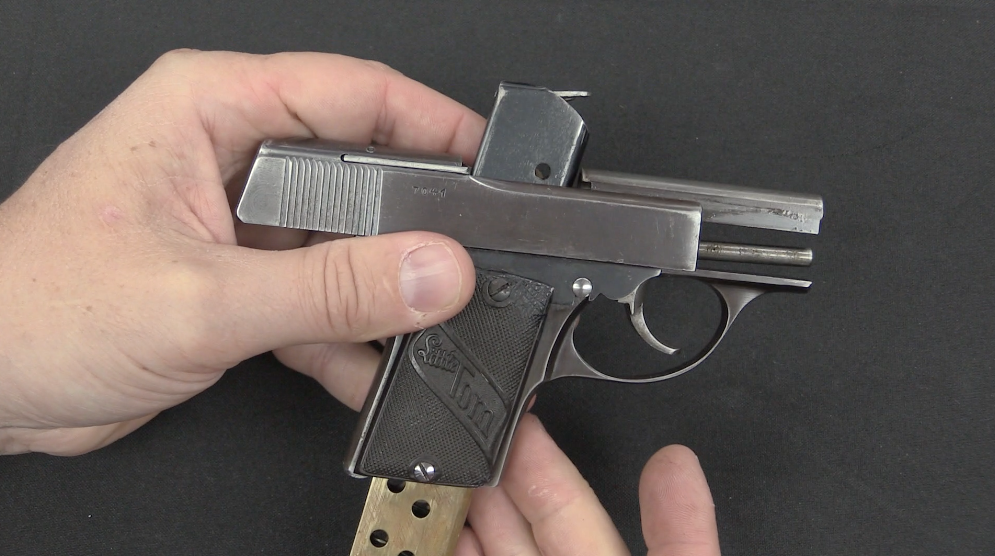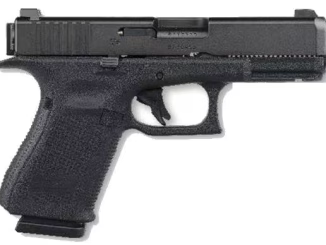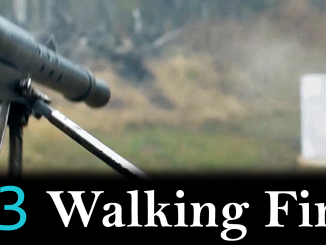02:30 – 17th Century hall
06:12 – 18th/19th Century hall
09:29 – World War One hall
17:13 – World War Two hall
20:24 – Naval history area
I recently had a chance to visit the Austrian Museum of Military History, and figured it would be nice to film a tour for the channel. The museum is in Vienna (the address is actually “Arsenal 1”) and is one of the oldest continuously-operating military museums in Europe. There are four main galleries, and while they have a lot of very good sub-collections I think the real strength of the museum is the World War One section.
A few of the highlights include:
– Perhaps the best collection extant of 17th century Turkish arms
– A 380mm WW1 siege gun
– Girandoni air rifle and it’s air pump
– WW1 compressed-air mortars
– Salvatore-Dormus machine guns, and several Villar Peruses
– Artifacts from the assassination of Franz Ferdinand, including his car and uniform and three of Princip’s groups’ FN 1910 pistols
If you are in Vienna, it is definitely a museum worth stopping in to see! I am looking forward to a future visit myself to see the new World War Two exhibits, which are expected to open in 2024.




Been there, great place. Went through it on June 26, 2014. Two days before the 100 year anniversary. Sadly, they had the car and uniform covered over but it is a very neat museum.
Don’t forget the tanks out in the back. Have a few from the Cold War and odd stuff here and there.
After taking the walk, try the little beergarten outside in the park. Nothing special, as far as beer gartens are concerned but perfectly placed for a draft after walking around for a few hours.
It is an excellent museum, ’tis true. Awe-inducing collections. I particularly liked how WWI–the Great War was curated there.
Austrians have certainly a knack for building good museum exhibitions. There are so many good ones in Vienna alone. Certainly worth visitng a few while in the city.
Great overview of military museum, by a country which does not usually dominate military history as the more recent, larger protagonists. I’m now encouraged to take the time to visit, when in Vienna again.
“Don’t forget the tanks out in the back”
One got away. Arnold Schwartznegger was able to buy the actual M47 tank he served on in the Austrian Army.
https://www.wearethemighty.com/mighty-history/arnold-schwarzenegger-army-tank/
https://www.thethings.com/arnold-schwarzenegger-tank-shipped-to-the-us/
If they ran out of ammunition, they planned to have Ahnold throw rocks at the enemy
“Perhaps the best collection extant of 17th century Turkish arms”
Presumably booty from the Siege of Vienna of 1683 – where the Polish-Lithuanian Army under Jan II Sobieski saved Christendom.
https://en.wikipedia.org/wiki/Battle_of_Vienna
And compressed air mortars were no joke
https://roadstothegreatwar-ww1.blogspot.com/2019/08/weapon-of-war-compressed-air-trench.html
https://www.thefirearmblog.com/blog/2018/05/15/when-air-guns-became-the-king-of-battle-pneumatic-trench-mortars-in-wwi/
One advantage of such weapons was they were almost silent, unlike conventional weapons, and the sudden explosion out of nowhere was devastating to morale
The main advantage of the compressed air mortars was that they economized on propellant powder, which Austria was as short of as everybody else by the middle of 1915.
But yes, the reduced sound signature compared to a conventional mortar was useful, too. They weren’t silent by any means, but they also didn’t have a muzzle flash or generate smoke. This made them useful for night bombardment, not to mention making them less vulnerable to being spotted and subjected to counterbattery fire day or night.
See The Guns 1914-18 by Ian V. Hogg.
cheers
eon
“where the Polish-Lithuanian Army under Jan II Sobieski saved Christendom.”
You mixed kings, Jan II was Ioannes Casimirus whilst above-mentioned feat was done by Jan III i.e. Ioannes III Sobiscius
Daweo, Thanks for the correction, I keep getting my King Jans mixed up
If you come to Vienna again, time your visit so as to be in on one of the two annual events, one celebrating uniforms from the beginnings to now and the other concentrating on military vehicles. I can be your guide – living in Vienna. And I can show you round a few other places, amongst them the public shooting range of the Steyr factory near Wiener Neustadt…
Don’t forget 1516 Brewing Co. Sat and drank beer while filling out postcards. The cards got increasingly less legible as the day went on…..
https://www.1516brewingcompany.com/
Also in Denmark we have a very fine War Museum, with very complete collections, as they get donated free copies from several factories, H&K – to keep them up to date.
I hope the Czech Army Museum will reopen soon for your perusal. Along with a number of Holek Bros prototypes, they also have the only known remaining example of the Chauchat-Sutter 1913 aircraft observer’s gun on display, and it is a truly strange bird.
Meanwhile you can browse exhibits online e.g. http://www.vhu.cz/exhibit_category/automaticke-palne-zbrane/
Posted this on YT but I figured I’d post it here too:
The gun at 15:54 is not a Villar Perosa, it is an Austrian-made Sturmpistole. Austria reverse-engineered a 9x23mm copy of the Villar Perosa in mid-1917 and debuted it at the Battle of Caporetto, where it was used by stormtroopers. It was mounted to a wooden tray which could be used as a flat stand or hung around the user’s chest for “hip-firing”. They were made at Skoda and Steyr.
About 15,000 Villar Perosas were produced during WW1 and were a pretty common weapon on the Italian Front, so it is not too surprising that Italian, Austrian, and Czech museums have a large number of examples. The Sturmpistole, on the other hand, is incredibly rare and no more than 500 were made.
Great tour of the museum btw, makes an interesting change from the usual content!
Any interesting small arms in the reserve collection, not on display?
Amazing timing!
I have just started re-reading the Prohaska novels by John Biggins. Your tour of the WWI section, Franz-Ferdinand’s car and bloodstained uniform, the uniforms and weapons, the Naval display at the end, all brought this series to mind immediately. Much of what is on display in that section features in the books.
Biggins is a British author that wrote a series of books set around WWI following the adventures of his fictional protagonist Otto Prohaska, and officer in the Austro-Hungarian Navy. The genesis of the series came about when he came across a photo album in an antique shop with photos of a WWI Austro-Hungarian submarine crew and it sparked his imagination.
The four part series details the life and adventures of Otto Prohaska, an ethnic Czech who becomes a naval officer and aviator. It is very much like the Flashman series by George MacDonald-Fraser, in that it involves a fictional character that somehow manages to get mixed up in all the pivotal events of his time and place, with great attention to historical accuracy, illuminating the history and events of the time.
In this case, unlike Flashman, he is an actual hero and good guy, rather than the poltroon, coward and toady that is the Flashman character. It also follows the same format, out hero, nearing the end of his life, is producing his memoirs, and the series is not chronological, but follows a particular theme or story line, out of order.
The books cover our hero’s early life and the ethnic politics of his time. His early career as a cadet on a round the world training ship voyage and the adventures that result. Another book covers his time as a U-Boat commander and ace in WWI. His career is somewhat inspired by that of Georg Von Trapp, of The Sound of Music fame, and there are references to him a number of times. Another details his pre-war adventures as an early military aviation pioneer and a stint as aide-de-camp to Franz-Ferdinand, and the assassination that triggered the war, and how he ends up at Port Arthur fighting the Japanese as a result, and his escape and return via the Dutch East Indies and North Africa. Another details time spent as an aviator on the Italian front and the Battle of Caporetto.
There are also references to the inter-war period and WWII, without going into any detail. It is clear that our protagonist ends up serving post war in several east European and South American navies, ends up involved in WWII with SOE or some other British intelligence service, spends time captured and in a concentration camp, ending up as a stateless refugee, settled in the UK, where he ends up writing the memoirs that form the novels in the last years of his life in an old folks home in Wales.
The stories are incredibly well researched, and I learned an incredible amount about the politics, military technology, history and sociology of the old Dual Monarchy. They are also extremely entertaining, amusing, absurd, and illuminates the time and place. You learn while being thoroughly entertained.
For us forgotten weapons fans, M-95 rifles and carbines, Roth-Steyr pistols,
Schwarzlose machine-guns, and a host of others are featured, as well as ships, submarines and aircraft.
I can’t recommend them enough, and having seen the displays at the museum that are directly referenced in the books, this museum definitely goes on the bucket list.
For anyone interested, the books are:
The Emperor’s Coloured Coat
A Sailor of Autria
The Two-Headed Eagle
Tomorrow the World
His other series (two books so far), are similar, but dealing with the adventures of a Flemish Surgeon’s apprentice around the time and events of the 30 years war, involving King Gustav-Adolph of Sweden, the sinking of the warship Vasa (another museum tie-in), the Dutch revolt against Spain, the English campaign against Spain under Charles I, and so on. Also highly recommended.
“(…)round the world training ship voyage(…)”
I assume this is corrupted spelling for circumnavigation if this is not case ignore this post entirely. Project Gutenberg provides series of documents describing how Navara did that in 1850s
Narrative of the Circumnavigation of the Globe by the Austrian Frigate Novara
Volume I https://gutenberg.org/ebooks/38456
Volume II https://gutenberg.org/ebooks/38462
Volume III https://gutenberg.org/ebooks/38478
Very interesting video. Aside from the obvious thing of arranging to do a segment on some of the weapon series display guns discussing the development of those arms, a list of museums, with reviews like this would be very useful for someone planning a trip.
I’d like to suggest posting as comprehensive a list of of arms and technology museums as possible (i.e all you know of) with videos of the ones you’ve been to.
I started to watch expecting that the funeral casket of Eugene of Savoy and the Sultan’s tent would both be part of your tour. You ignored them both although i got a brief glimpse of Prince Eugene’s box in the background. I suppose its not your period. I used to be a regular visitor before the pandemic. The more modern firearms are very interesting and on open days they are sometimes demonstrated. I saw one the most disgusting pieces of historic ordinance on an open day. It was a small artillery piece. After it was fired it was almost completely covered in cockroaches that swarmed out of various nooks and crannies. Apparently the lubrication was pigs grease and the roaches had been having a feast…